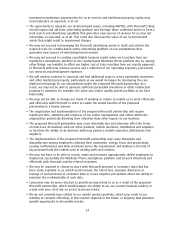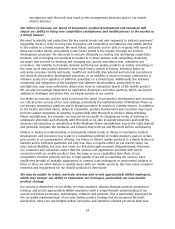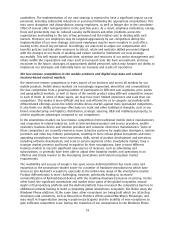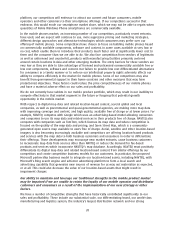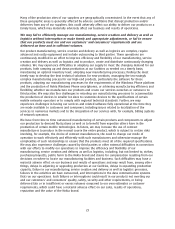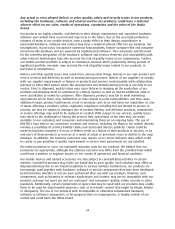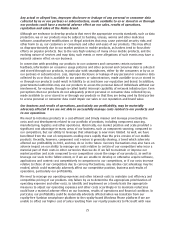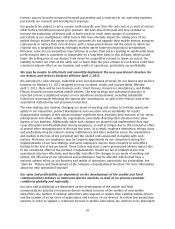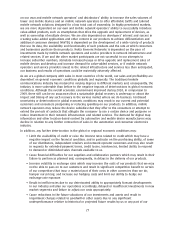Nokia 2010 Annual Report Download - page 22
Download and view the complete annual report
Please find page 22 of the 2010 Nokia annual report below. You can navigate through the pages in the report by either clicking on the pages listed below, or by using the keyword search tool below to find specific information within the annual report.relationships with our mobile operator and distributor customers. Going forward, these strengths are
critical core competencies that we will bring to the proposed partnership with Microsoft and the
implementation of our Windows Phone smartphone strategy. Our ability to maintain and leverage
these strengths also continues to be important to our competitiveness in the mobile phones market.
As discussed above, however, the proposed Microsoft partnership and the adoption of Windows
Phone as our primary smartphone platform are subject to certain risks and uncertainties. Several of
those risks and uncertainties relate to whether our mobile operator and distributor customers and
consumers will be satisfied with our new strategy and proposed partnership with Microsoft. If those
risks were to materialize and mobile operator and distributor customers and consumers as a
consequence reduce their support and purchases of our mobile products, this would reduce our
market share and net sales and in turn may erode our scale, brand, manufacturing and logistics,
distribution and customer relations. The erosion of those strengths would impair our competitiveness
in the mobile products market and our ability to execute successfully our new strategy and to realize
fully the expected benefits of the proposed Microsoft partnership.
Also, as result of market developments, competitors’ actions or other factors within or out of our
control, we may not be able to maintain these competitive strengths that we have benefitted from
historically. It is also possible that such strengths or some of them become less relevant in the future
or are replaced by other type of strengths required for future success in the mobile product market.
If any of the companies we partner and collaborate with, including Microsoft, were to fail to
perform as planned or if we fail to achieve the collaboration or partnering arrangements
needed to succeed, we may not be able to bring our mobile products to market successfully or
in a timely way.
We are increasingly collaborating and partnering with third parties to develop technologies and
products for our smartphones and mobile phones. These arrangements involve the commitment by
each party of various resources, including technology, research and development efforts, services and
personnel. Today, mobile products are developed in an ecosystem of multiple partnerships with
different industry participants where our ability to collaborate successfully with the right partners is
critical to our success in creating and delivering mobile products that are preferred by our customers
and consumers. Although the objective of the collaborative and partnering arrangements is a
mutually beneficial outcome for each party, our ability to introduce new mobile products that are
commercially viable and meet our and our customers’ and consumers’ quality, safety, security and
other standards successfully and on schedule could be hampered if, for example, any of the following
risks were to materialize:
• We fail to engage the right partners or on terms that are beneficial to us.
• We are unable to collaborate and partner effectively with individual partners and
simultaneously with multiple partners to execute and reach the targets set for the
collaboration.
• The arrangements with the parties we work with do not develop as expected.
• The technologies provided by the parties we work with are not sufficiently protected or
infringe third parties’ intellectual property rights in a way that we cannot foresee or prevent.
• The technologies or products or services supplied by the parties we work with do not meet the
required quality, safety, security and other standards or customer needs.
• Our own quality controls fail.
• The financial condition of our collaborative partners deteriorates which may result in
underperformance by the collaborative partners or insolvency or closure of the business of
such partners.
• Our increasing reliance on collaborative partnering for Nokiabranded or cobranded products
21





